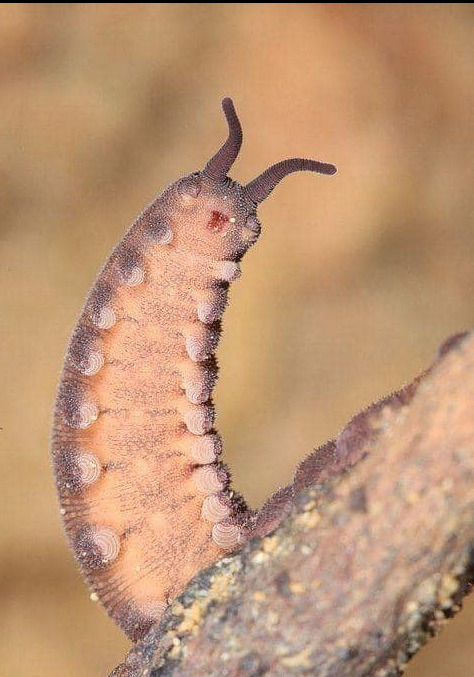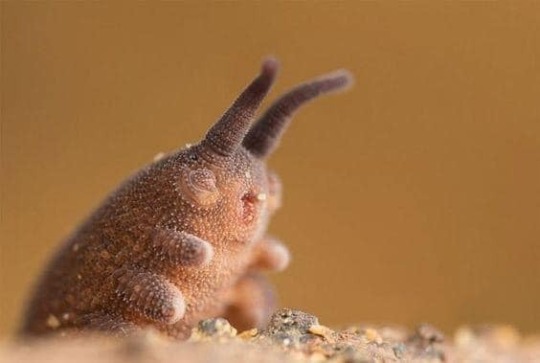Hai, welcome to my little magical place! ✨️ This is a side blog for all things nature related. My current loves are Frogs, Fungi, Moths, and Wolves 💚 I will also sometimes post/reblog with interesting facts. You can find them under "glooms nature facts". It's always fun to expand your knowledge :) Blooming under @imperium-of-vibes love ❤️🔐
Last active 3 hours ago
Don't wanna be here? Send us removal request.
Text

Some predatory mosquito larvae are capable of shooting out their gross little heads like harpoons to grab prey.
Article
5K notes
·
View notes
Text
Mushroom fact of the week!
Mushrooms scam trees!
Some fungi get their nutrients by exchanging nutrients with plants. The fungi provides phosphorous and the plant gives carbon in return.
The less phosphorous available, higher price the plant will pay for the phosphorous, giving more carbon for each unit received. However, when there is more available the fungi will receive less carbon for its troubles.
So what these fungi do, being the scammers they are, is transport phosphorous through the mycelium from areas of high abundance to areas of low abundance where it is more scarce and fetches a higher price. This way, the fungi is able to get much more carbon out of the plant.

48 notes
·
View notes
Text


by Caitlin
#nature#woods#nature aesthetic#forest#sunlight#greenery#branches#mother nature#narure is beautiful#trees#calmingvibes
16K notes
·
View notes
Text
Surinam Toad (Pipa pipa)
These frogs are fully aquatic, so the rainforest makes a perfect home. They can be found in the bottom of muddy rivers or flooded forest areas in South America. Measuring from 4 - 8 inches.

Surinam Toads are almost entirely flat, which helps in camouflaging when predators are around.
They also lack tongues! So this prevents them from capturing food like other frogs would. Instead, they use suction capture. They are an ambush hunter, lying, patiently waiting for prey to pass by like crustaceans, small fish, and worms.

Now, what makes this frog even more unique, is they have an unusual way of reproducing. Males will call to the females under water by making a clicking noise. Any willing female will produce around 60 to 100 eggs, the male will fertilize them and push the eggs on to the females back, where they will stick to her skin. After a few days her skin will grow up around her eggs, kind of looking like honeycomb.

After the the eggs hatch, her young will stay under her skin for up to 4 months to develop!
When ready and formed, the little toadlets will wiggle themselves loose and pop out of her skin. They will make their way to the waters surface and begin their lives.

photo links: 1, 2, 3,
#glooms nature facts#animals#herpetology#amphibians#nature#wildlife#frogs#toads#surinam toad#interesting#mother nature#nature is beautiful#interesting facts#facts#frog#🐸#trypophobia
2 notes
·
View notes
Photo
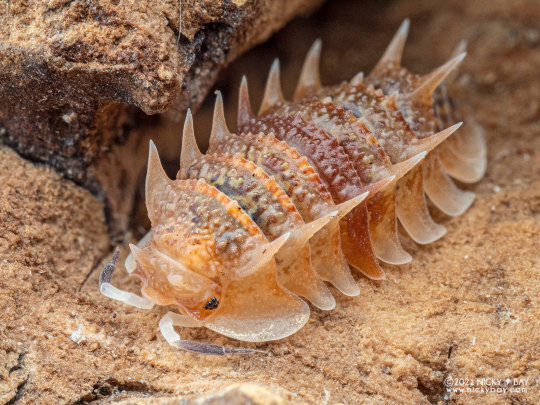

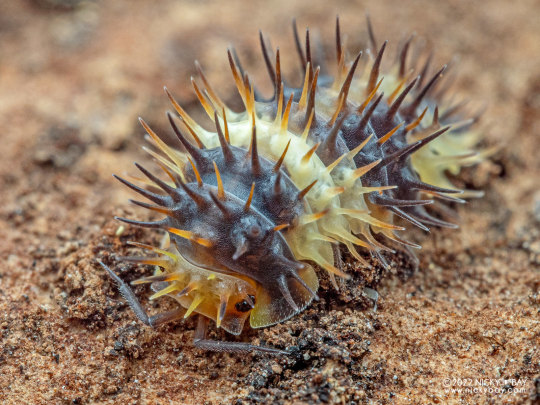

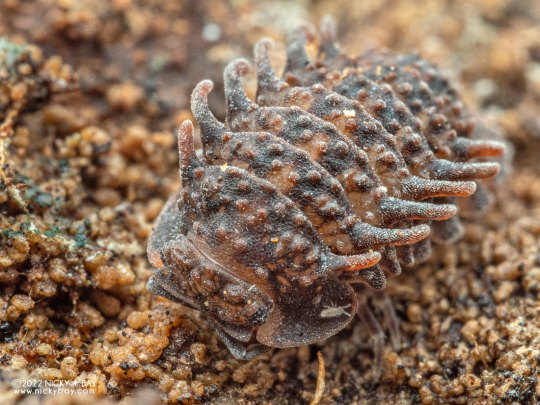
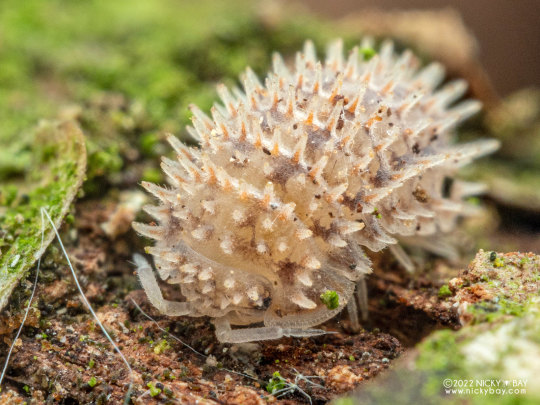
Armored woodlice:
1. Pseudarmadillo spinosus 2. Unknown, Armadillidiidae 3. Loreola sp. 4. Loreola sp. 5. Unknown, Armadillidiidae 6. Echinarmadillidium fruxgalli
Photos by Nicky Bay // Facebook // Website
Shared with permission; do not remove credit or re-post!
12K notes
·
View notes
Text
Feather Horned Beetle (Rhipicera)
This uncommon, very small beetle ranges from 10-25 mm in length, it is black and white, wedge shaped, and can be easily identified by its large fan-like antennae. The males differ from females as their antennae are much bigger and more pronounced, containing over 20 segments. They use them to locate female feather horned beetles that are ready for mating.

Larvae of this genus has never actually been spotted, but it is thought that they may be the parasites that attack Cicada larvae. Many in the Rhipiceridae species are endoparasitic and ectoparasitic. The eggs are laid in time for flowers to bloom, then attach themselves to a pollinating insect, where the larvae is then brought to the insects nest. The host will then be attacked and the larvae will start to feed on the inside and start to develop. Once enough nutrients are recieved, they will emerge as tiny beetles.

Photo sources: 1, 2
#nature#glooms nature facts#beetles#beetle#facts#interesting facts#feather horned beetle#mother nature#nature is beautiful#bugs#insects#insect facts#bug facts#interesting#larvae
3 notes
·
View notes
Text
Amethyst Deciever (Laccaria amethystina)

The Amethyst Deceiver is a very stunning violet mushroom, and it can be found in various woodland environments around Europe, Asia, and the Americas. They prefer to be close to beech or oak. These mushrooms are small with a convex to flattened cap and a tough fibrous stem. They tend to start out as a light lilac/purple and eventually fading to brown.

Amethyst Deciever is indeed edible but, with how it changes color throughout any weather changes and the season, it can be difficult to properly identify, hence the name "Deceiver". Look a-likes include Lilac Firecaps and some various types of Webcaps with similar coloring.

They can be used in many recipes. With keeping it's vibrant purple color even after cooking, it can help liven up dishes!
Image sources: 1, 2, 3
#glooms nature facts#mushroom#amethyst deciever#amethyst#fungi#fungus#mother nature#nature is beautiful#interesting facts#facts#nature#interesting#purple#purple mushroom#fungi facts#fungi aesthetic#wild fungi#spores
3 notes
·
View notes
Text
Spiny Devil Katydid (Panacanthus cuspidatus)
The Spiny Devil Katydid can be found in the lush forests of Brazil, Ecuador, Peru, and Panama. They are also commonly referred to Spike-headed katydid or Thorny Devil katydid.

This katydid has a red 5 pointed horn that protrudes from its head. It is covered in an exoskeleton that provides support and protection. The body can be various shades of green to help with camouflaging, and they have red eyes, with yellow to orange mandibles. They can get up to 3 inches in length, with the female being larger. Its antennae can grow even longer than the body!
There are several ways the katydid can protect itself against danger. Their wings or long hind legs can be used to escape far enough out of enemy range. Their spiny legs can be used to fight off or trap the enemies and prey. But if this all does not work, they will use their powerful jaws to inflict painful bites. These bites can even pierce human skin.

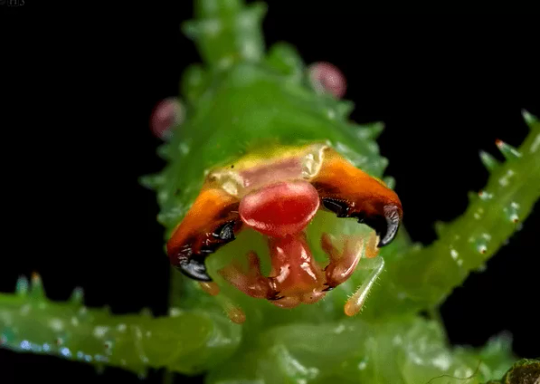
Spiny Devil Katydids can fly for short distances when they must but more than often prefer to walk and climb. They also use their long hind legs to jump long distances, just like an average grasshopper. They have poor eyesight in the dark but have an excellent sense of smell to find food. Also, having such long antennae, they can be used to scan the air for food sources as well as detecting danger. This species of katydid is omnivorous, so enjoys eating plants but will supplement their diet with snails, frogs, caterpillars, and even other katydids.
youtube
When darkness falls in the forests, the males will begin to sing, scraping his wings together. This loud and high-pitched whistling can reach far and high to reach the females ears. Now, whats really cool is that katydids have great hearing, but they do not have actual ears. They have a special organ called a tympana. It is like two eardrums just below the left "knee" that can capture sounds us as humans can't hear.

Image links: 1 2 3 4
#katydid#glooms nature facts#spiny devil katydid#nature#interesting facts#facts#bugs#insects#flying insects#grasshopper#interesting#bug facts#insect facts#nature facts#green#spikes#thorny devil#Youtube#entomology#beetle
1 note
·
View note
Text

Going retro. I was tidying up in the garden and found this shell that had a leopard slug living inside it.
#heh this is amazing i love it#leopard slug#snail#slug#bugs#funny#cute#laughs#insects#mollusk#nature is magical#nature#mother nature#silly
4K notes
·
View notes
Text
Hag Moth Caterpillar (Phobetron pithecium)
The Hag Moth Caterpillar, also referred to as the Monkey Slug, can be found in Eastern North America and into the Midwest. It's about 1 inch in diameter and is most known for having a very bizarre appearance, like a visual oddity. They are also part of the slug moth caterpillar family, which have sucker's and move just like slugs.

The appearance can vary widely, with many shapes and bright colorations. The caterpillar has 6 hairy appendages, and is cleverly designed to help with camouflaging techniques to avoid predators. When not moving, it could be mistaken for a dead leaf, but when it is moving, it can be mistaken for a tarantula instead!
Although it uses sucker's to move around, the Hag Moth Caterpillar still has itty bitty true legs near its head and under the thorax. Ooh, and its belly is transparent, so you can see their open circulatory system in action!


Now, it is important to note that these guys have spines underneath their small hairs that can be irritating or painful upon contact if you ever come across one. So it is more of a look, do not touch situation.
Despite the extraordinary appearance they have as a caterpillar, they do not metamorphosize into anything just as crazy. The Hag Moth is a mottled brown, super furry, and has tufts of hair that extend from every leg. The males have more of a translucent wing, while the female has light ivory hairs on her legs and is much larger in size. Adult moths are also a lot rarer to find out and about.
Male:


Female:


Paired:

Image links: 1, 2, 3, 4, 5, 6, 7, 8
#moth#glooms nature facts#entomology#lepidoptera#moths#hag moth#nature#nature is beautiful#interesting facts#facts#bugs#insects#interesting#flying insects#bug facts#moth facts#wings#insect facts#hag moth caterpillar#monkey slug
108 notes
·
View notes
Text
Devil’s Fingers (Clathrus Archeri)
Devil's fingers, often referred to as octopus stinkhorn, is a rare fungus that was first discovered in Britain, 1914. It's found in decaying matter like mulch, in both woodlands and grasslands but is scarce all throughout the U.K.

This eerie red, tentacle like mushroom sprouts from an egg-shaped pod that is called a witches egg. The Devil's Fingers usually has 4-7 slender and spongy arms. Each arm can grow up to 10cm, and a sticky black substance filled with spores (gleba) coats the tendrils. When it reaches full maturity, it begins to smell of putrid rotting flesh, which attracts insects. The spores are then spread by the visiting insects wherever they land next.

#devils fingers#octopus stinkhorn#mushroom#fungi#fungus#interesting facts#nature#nature is beautiful#facts#glooms nature facts#insects#fungi facts#spores#tentacles#witch#devil#mushroom facts#interesting#red
52 notes
·
View notes
Text
The Southern Flannel Moth (Megalopyge opercularis)


Cute and oh so furry, am I right? These moths are widespread throughout the United States and commonly found on the East Coast stretching from New Jersey to Florida. Though they are completely harmless as adults, behind all that thick and lengthy, almost fur like hair, they have a sneaky little secret.
The larvae of this species is one of the most venomous caterpillars in the U.S. and are capable of delivering a sting so painful, it's described as a knife like feeling in your bones or getting bit by a snake. Some even say it resembles the sensation of amputation!
The caterpillar also goes by the name Puss Caterpillar, Asp Caterpillar, or Woolly Slug. They can be between 1-1.5 inches and have long hairs covering their entire body. These hairs act like stinging spines that carry toxic venom inside. As the caterpillar grows, they become curly and fluffier, making them look even more approachable and pet-able. But, the older they get, the more potent their venom becomes.

Now, before you panic, they are not actively out to attack, and their sting isn't lethal. But it is an extreme discomfort. A simple touch, just brushing past, is enough to cause the hairs to break off and inject their venom. Pain begins in minutes and increases quickly. It can spread all throughout the limb or affected area, then eventually the whole body. It is usually followed by redness and swelling as well. So, if you see the moths around, it is safe to assume there are many caterpillars nearby or waiting to be born.
Be safe and be smart, my friends.
Image links: 1 & 2, 3
#moth#lepidoptera#glooms nature facts#caterpillar#facts#interesting facts#moths#bugs#insects#flannel moth#flying insects#bug facts#insect facts#cute#fluffy#nature is beautiful#nature#venom#venomous#butterfly#wings#entomology
236 notes
·
View notes
Text
Jewel Caterpillar 💎
Nudibranchs of the forest!


These stunning little guys are from the Dalceridae family and native to Costa Rica, Mexico, and several Caribbean Islands. There is still little know about these caterpillars and their moth counterparts. They may look sizeable, but they are, in fact, very tiny, about half an inch in size. Jewel Caterpillars are gelatinous and underneath the glass like goop there are spikes coming out of the cuticle. Now, these spikes are easily detachable, and the goop acts as a defense to predators! It is still unclear if the goop is toxic, but if an ant or wasp attacks, it will get these goop stuck in its mandibles, which buys the caterpillar time to escape.
Unfortunately, though with their bright colors, impenetrable gelatinous body, and defense spikes, they also have a weak spot. That is their belly. It turns out parasitic maggots can get underneath them and drills through the unprotected belly, taking up residence. So, as the caterpillar eats and gains more weight, the invader is also being fed. Once big enough, the maggot consumes the inside of the caterpillar in quite a short period of time. This is no way for such a pretty little thing to go.


Jewel Caterpillar Moth - Acraga Coa
After undergoing pupation, oange, fuzzy and stylish moths emerge! The average wing span can be 1-3 cm and their season is year round. The females have a quick drying liquid that they spray on their eggs. This function of the liquid is still unknown, but theorized it is to help glue the eggs in place and provide protection from predators.


Image links: 1, 2, 3, 4, 5, 6
Also, I covered some facts a while back about Nudibranchs, so go take a peek!
#glooms nature facts#lepidoptera#nature#moths#nature is beautiful#interesting facts#insects#caterpillar#jewel caterpillar#orange#colorful#nudibranch#facts#bugs#flying insects#bug facts#insect facts#forest#nature facts#entomology
16 notes
·
View notes
Photo
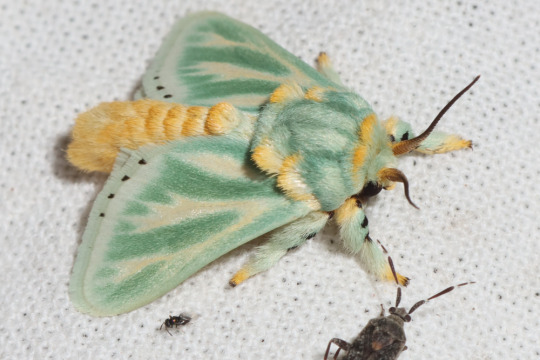



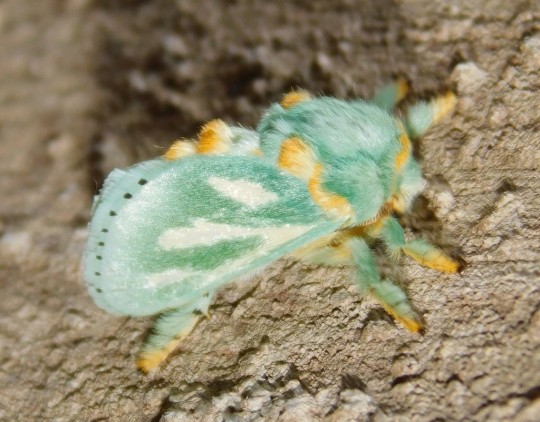
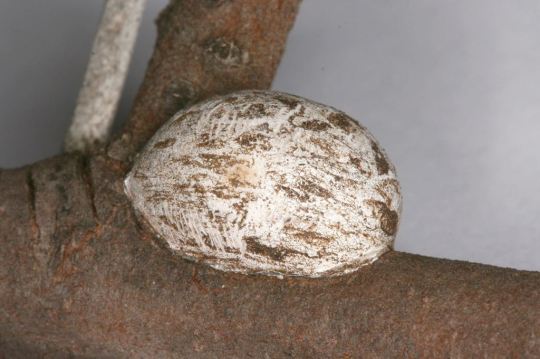
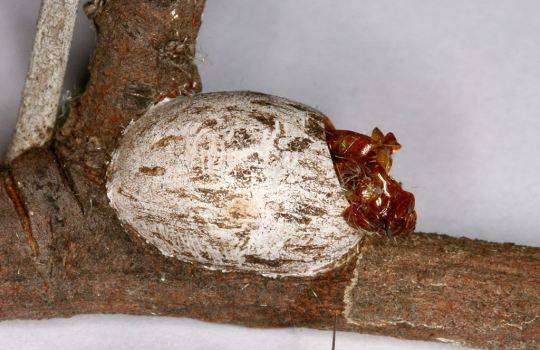
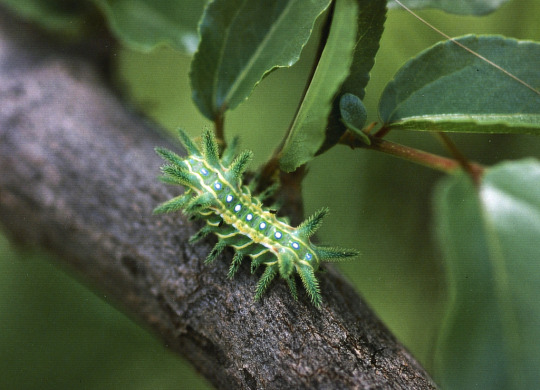
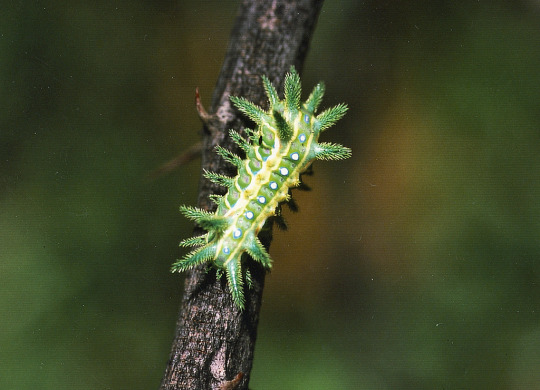

Southern African slug moth, Coenobasis amoena, Limacodidae
Photo 1 by thijsvalkenburg, 2 by nikiescott, 3 by fubr, 4 by Bernard Dupont, 5 by qgrobler, 6-7 (cocoon before and after moth emerged) by nikiescott, 8-9 by wolfachim, and 10 by suncana
#nature#mother nature#moth#moths#slug moth#insects#bugs#slug caterpillar moth#caterpillar#larva#southern african slug moth#cup moth#cocoon#pupa#limacodidae#Coenobasis amoena#lepidoptera#lepidopterology#flying insects#green#green bugs#wings#butterfly#interesting#facts
16K notes
·
View notes
Text
FOTD #121 : tiny blue lights! (mycena lazulina)
tiny blue lights are little bioluminescent mushrooms in the family mycenaceae :-) there is not much known about them as they were only discovered in 2016, but so far they have been documented in southwestern japan !! they are also saprotrophic (feed on dead organic matter).
the big question : can i bite it?? the edibility is unknown thus far. ^^"

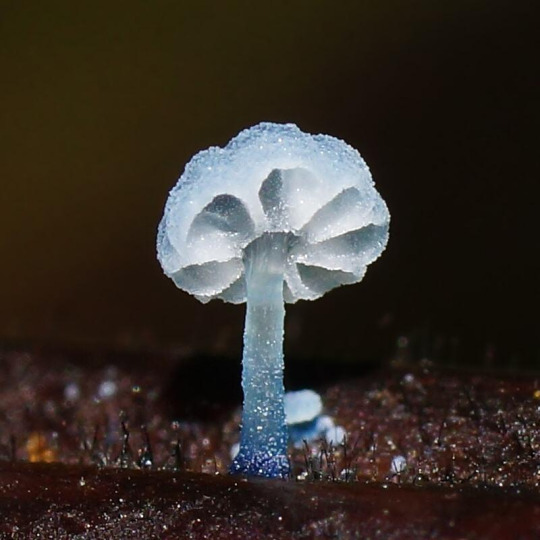
m. lazulina description :
"tiny blue lights are small & bioluminescent. the have the following traits : gills on hymenium, cap is convex, hymenium is adnate, stipe is bare. the cap is light blue to white, the gills are white & the stipe changes from white to dark blue down the length. visually, it appears as if dusted with sugar."
[images : source & source] [fungus description : source, which was pieced together by me !!]
#: tiny blue lights :#[mycena lazulina]#mushroom#mushrooms#mycology#earth#nature#cottagecore#fungus#forestcore#foraging#fungi#mycena lazulina#tiny blue lights#fotd#fungus of the day#fungicore#nature is magical#they are so cute#mushies
817 notes
·
View notes
Photo

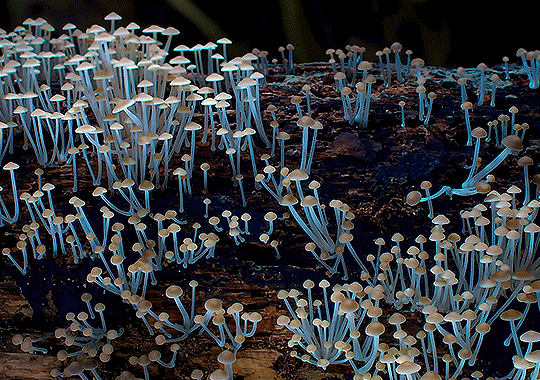

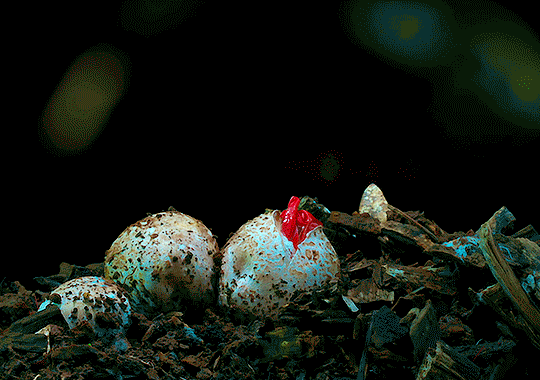
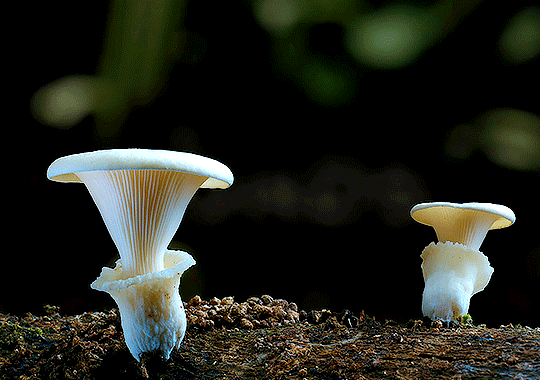
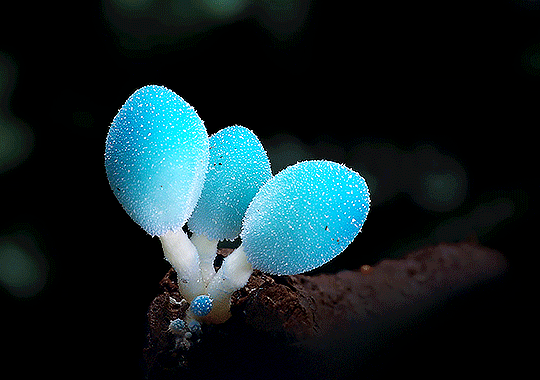
Planet Earth II (2016) Episode 03 “Jungles” Directed by Emma Napper
#mushroom#mushrooms#mother nature#planet earth#interesting facts#fungi#fungus#nature facts#nature is magical#mycology#gifs#mushroomcore#fungicore#nature is beautiful
67K notes
·
View notes
